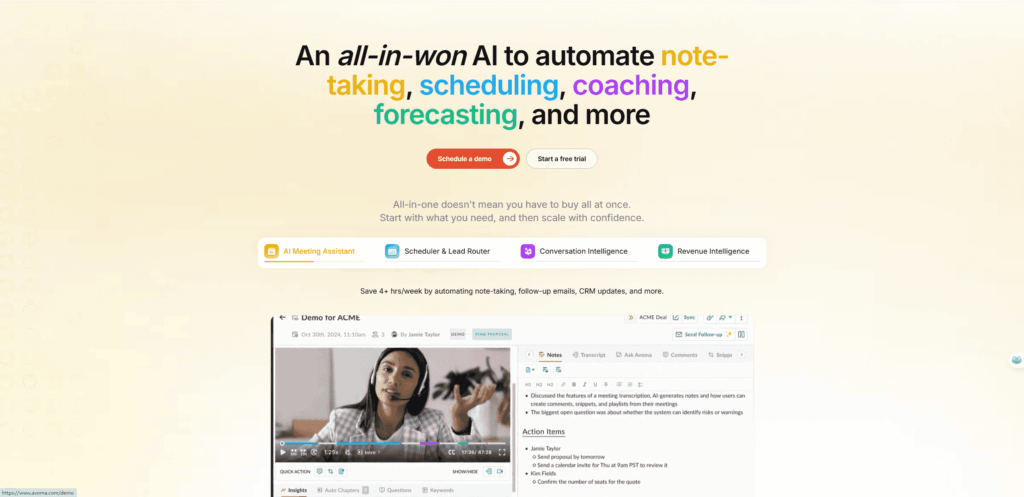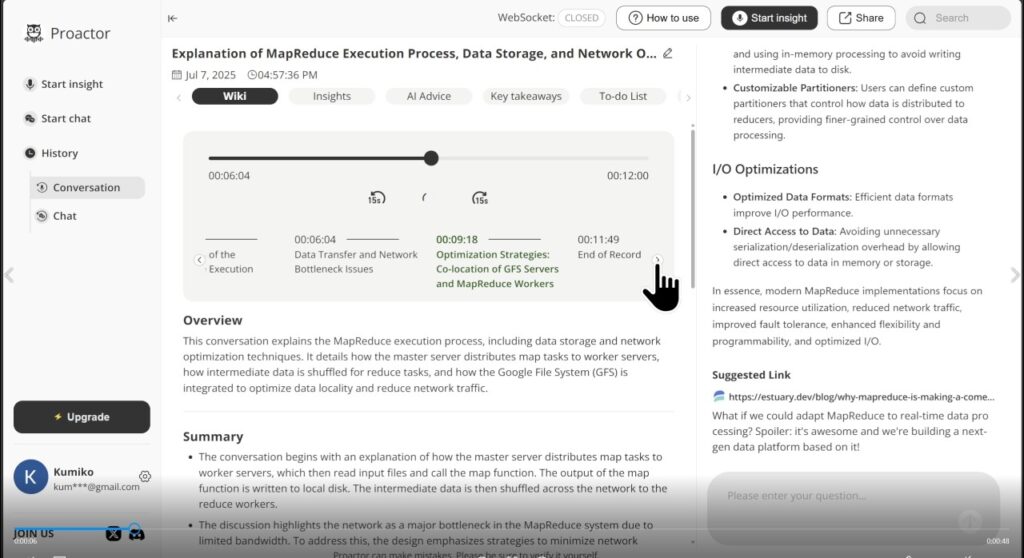When I first got on Avoma, I thought I’d hit the jackpot. I mean, here’s this platform that can automatically transcribe my calls, keep my meeting notes organized, and even push everything right into my CRM. No more bouncing between three different apps — at least that’s what I hoped.
At first glance, it checked all the boxes: pre-meeting agendas, live speech-to-text, AI summaries, bookmarks, Salesforce integration… the whole deal. I remember thinking, “If this works like they say, my work life’s about to get way easier.”
And it did — in some ways. But after a few months, I realized something: Avoma was awesome at recording and organizing my meetings… it just didn’t help me win the meeting while it was happening. That’s when I tried Proactor — and, honestly, I’m not going back.
My Experience with Avoma

The Good Stuff
To be fair, Avoma’s pretty slick.
- Before the meeting: It pulled in my calendar automatically. I could drop in an agenda without hunting for old notes. For my QBR with a client, I had KPIs, budget notes, and follow-ups all set before we even joined the call.
- During the meeting: The automatic transcription kicked in right away. Accuracy was decent, and I loved being able to drop bookmarks — like when a client hinted at an upsell.
- After the meeting: Avoma gave me clean AI notes, linked action items to timestamps, and pushed everything to Salesforce without me lifting a finger.
If you’re in sales or CS, that kind of automation feels like magic.
Price talk:
- Startup: $19 per recorder seat/month
- Organization: $29 per recorder seat/month
- Enterprise: $39 per recorder seat/month Add-ons like Conversation Intelligence? Another $19–29 per user/month. Sounds fine… until you realize you’re paying per recorder seat. If you’ve got a team, that number climbs fast. For me, as a solo user, it felt like buying a team plan I didn’t fully use.
The Frustrations
Here’s where things got a little less shiny.
- Accuracy dips: Noisy calls or two people talking over each other? The transcript sometimes went off the rails, and speaker labels got messy.
- Bot lag: Using the Avoma bot? Sometimes it joined late. And in a high-stakes call, missing the first minute can be brutal.
- Finding stuff: The feature set is huge, but when I just needed that one quote from a call two months ago, I felt like I was digging through a maze.
If you’ve ever sat there thinking, “Man, I wish my AI could help me right now, not just later,” you know exactly how I felt.
Then I Tried Proactor

The first time I fired up Proactor, it felt different — more like having a co-pilot than just a note taker.
- I said, “Let’s circle back next week,” and it popped up a prompt to schedule it on the spot.
- A client dropped a budget concern mid-call, and Proactor instantly suggested ways to handle the objection — right there, while the deal was still on the line.
- Weeks later, I typed, “What did we agree on with Acme’s Q4 budget?” — boom, Proactor pulled it from Global Context Memory in seconds. No transcript hunting, no re-explaining.
It still gave me automatic transcription like Avoma, but layered on real-time advice and a Meeting Wiki that broke everything down into clear actions, key decisions, and useful insights.
Pricing That Feels Different
Here’s the part that surprised me: Proactor wasn’t just more capable for my workflow — it was also a better fit for my budget.
Proactor Pricing:
- Pro: $15.99/month (1,350 transcription minutes + 3,400 AI credits)
- Business: $39.99/month (3,600 transcription minutes + 9,100 AI credits)
Even the free plan gave me 30 minutes of transcription and 100 AI credits — enough to try the real features, not just the recording function. And unlike Avoma, I wasn’t paying for multiple “recorder seats” I didn’t need.
Real Meetings, Real Difference
Here’s the deal:
With Avoma, if a client raised an objection, I’d jot it down and maybe handle it later in a follow-up email. With Proactor, I handled it in the moment because the AI flagged it and gave me talking points while the client was still engaged.
Or take that time I needed to remember exactly what delivery timeline we promised a client. In Avoma, I’d dig through transcripts. In Proactor, I just asked Potor AI Chat, and it told me — plus exactly when we said it.
Why This Matters for You
If you just want automatic transcription and tidy post-meeting notes, Avoma’s solid. You’ll have searchable records, action lists, and CRM updates.
But if you want an AI that:
- Has your back during the meeting
- Remembers months of conversations without you spoon-feeding it
- Suggests your next move before you even ask
- Works online and offline without a clunky bot joining
…then trust me, you’ll feel the same relief I did when I switched to Proactor.
Final Verdict
Avoma’s a polished automatic transcription tool for teams who live in their CRM.
Proactor? It’s the AI meeting partner that actually changes the game — helping you steer conversations, remember everything, and walk out of meetings ready to act.
👉 Try Proactor for free — you’ll notice the difference on your very next call.






